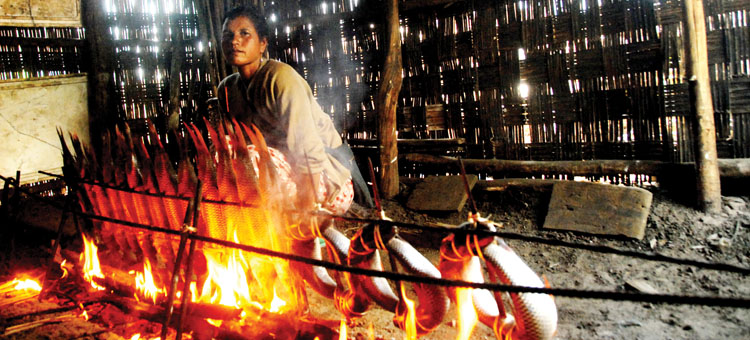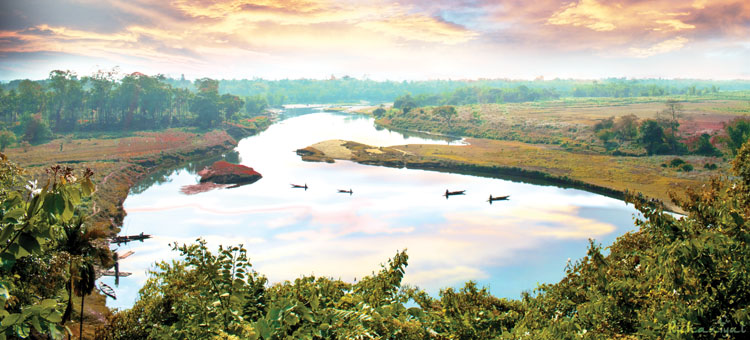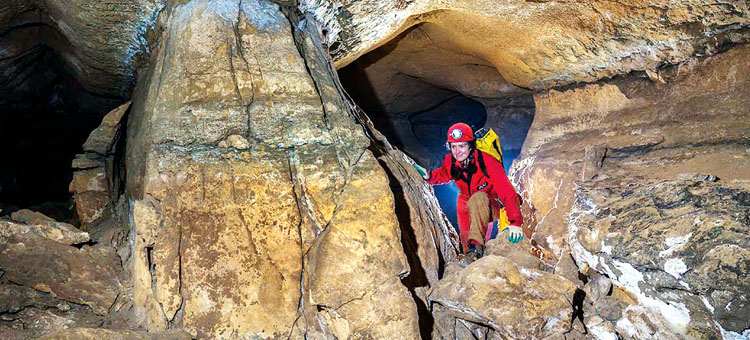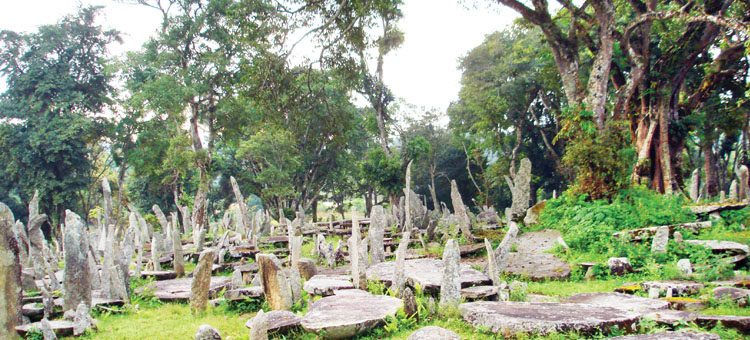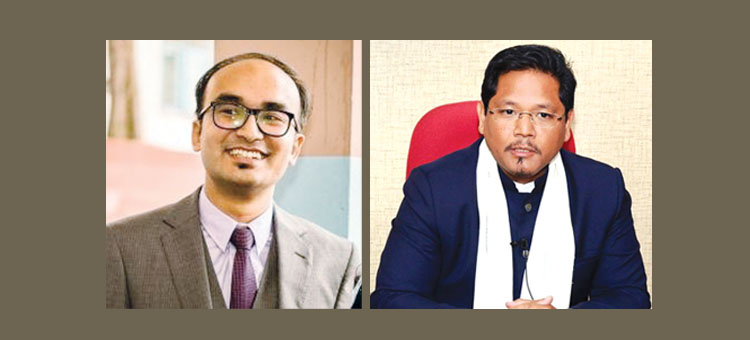Meghalaya: In July this year, Meghalaya got its name etched permanently in geological history.
The International Union of Geological Sciences (IUGS) ratified the classification of a phase of earth’s history as ‘Meghalayan Age’ after report of a detailed study was submitted to it for approval.
Intriguing limestone caves, mysterious living root bridges, sacred groves, majestic falls to misty hills, Meghalaya is the stuff travel dreams are made of. The ‘abode of clouds’ is India’s answer to surreal Scotland. With tourism in India looking east, the tiny North Eastern State has everything to make its way into the travel bucket-list. Welcome to the Age of Meghalaya!
Scientists have found the clearest chemical signal for a transition into the Meghalayan Age in the stalagmite formations rising from the cave floor in Mawmluh near Cherrapunjee, that indicate that the new age began 4200 years ago. A portion of stalagmite is now a Global Boundary Stratotype Section and Point (GSSP), an internationally-agreed boundary marker for a geological phase, the first formally ratified GSSP in India.
Carved out from the erstwhile State of Assam, Meghalaya became a full fledged State on January 21, 1972. Bounded on the North and East by Assam and on the South and West by Bangladesh, Meghalaya is a year round destination where the mercury hardly climbs above 25 degrees Celsius but falls as low as 4 degrees. It is one of the most beautiful places in India and offers abundant opportunities for adventure, rural, culture and ecotourism.
The State has many hills, caves, waterfalls, national parks and an 18-hole golf course, and is very rich in flora. Meghalaya’s capital, Shillong, also the District Headquarters of East Khasi Hills is situated at an altitude of 1496 metres above sea level and has a bracing climate throughout the year. No wonder it is called ‘Scotland of the East’.
The city is well-connected with motorable roads all-over, has its own charm, different from other hill stations, and presents a natural scenic beauty with waterfalls, brooks, pine grooves and gardens. The place, the people, the flora and fauna, and the climate all combine to make Shillong an ideal resort throughout the year.
Shillong offers amenities for tourists with good hotel accommodations, facilities for sports, angling, trekking and hiking. Sohra (previously known as Cherrapunjee) is an hour away from Shillong and literally the high point of any visit to Meghalaya. It is one of those ultimate eco-friendly destinations, a place renowned for having the privilege of receiving the highest rainfall in the world.
Meghalaya’s main ethnic communities, each having its own distinctive customs and cultural traditions are the Khasis (of Mon-Khmer ancestry), the Garos (of Tibeto-Burman origin) and the Jaintias (said to be from South East Asia). The common trait binding all three communities is the matrilineal system in which the family lineage is taken from the mother’s side. The people of Meghalaya are known to be hospitable, cheerful and friendly.
In the last decade the North East State has doubled tourist arrivals. In 2017, it breached the 10-lakh mark, registering ~20 per cent growth. FTAs are still less than 2 per cent and mostly from Bangladesh and other neighbouring countries. Meghalaya has hotels, guests houses and home stays totalling about 3500 classified rooms.
In August, Japan decided to lower the level of travel advisory to its people who would like to visit tourist destinations in Meghalaya. The Japanese government took this decision after Meghalaya Governor Ganga Prasad made a request to Japanese Ambassador to India Kenji Hiramatsu. The advisory was in place for decades owing to the law and order situation in the State.
But Meghalaya has only scratched the surface considering the immense tourism potential the State has. Apathy from the Centre and poor air connectivity have been major hindrances in claiming its rightful place on the sub-continent’s tourism map. But things are fast changing for the better with the central government’s new ‘Act East’ Policy.
The Union Ministry of Tourism (MoT) has sanctioned Rs. 99.13 crore under Swadesh Darshan Scheme’s North East Circuit for development of Umiam Lake View – Lum Sohpetbneng – Mawdiangdiang Orchid Lake Resort. In January 2018, MoT announced another Rs. 70 crore for development of places of worship spread across the State under the same scheme.
The prominent places of worship include Catholic Cathedral Church at Laitumkhrah in Shillong, Nartiang Durga Temple and Nartiang monoliths in Jaintia Hills, Jaiaw Presbyterian Church, Balupada Baptist Convention Centre in Garo Hills, Laban Glass Mosque and Gurudwara Sahib, besides other churches belonging to different Christian denominations and temples across the state.
The Department of Tourism (DoT) has plans to develop three distinct circuits: Garo Hills, West Khasi Hills and Jaintia Hills. In May, Meghalaya Chief Minister Conrad K Sangma submitted a memorandum to Union Minister of State (I/C) Tourism K J Alphons to implement Swadesh Darshan Scheme in Khasi, Jaintia and Garo Hills to enhance tourism potential of Meghalaya.
He also sought intervention from the Ministry of Civil Aviation to enhance air connectivity, further boost the infrastructural facilities at Shillong Airport and also to initiate work for operationalising the Baljek Airport in Garo Hills.
Meghalaya first came out with a State Tourism Policy in February 2001. It laid thrust on creating sustainable tourism with community involvement and local stakeholders, adventure tourism, rural tourism and ecotourism.
In 2011, it was decided to revamp the existing tourism policy and come up with a new policy which envisaged the Government helping to create the basic infrastructure for tourism development and also acting as a facilitator for private investment in this sector. Developing quality products and offering active support services would be the responsibilities of the private sector.
Keeping in mind the requirements to provide economic opportunities to the local communities as also the need to preserve the ecosystem and the ethnic identity of the people, the tourism policy was re-designed to sustain the rich cultural heritage and biodiversity of the State.
The Department of Industrial Policy and Promotion in the Ministry of Commerce and Industry has approved a package of fiscal incentives and other concessions for the North East Region viz. the North East Industrial and Investment Promotion Policy 2007.
Under this Policy, incentives for Service Sector has been covered for Hotels (not below 2 star category); Adventure and Leisure Sports including Ropeways; Vocational Training Institutes such as Institutes for Hotel Management, Catering and Food Crafts.
Other incentives include 100 per cent income tax exemption, capital investment subsidy, interest subsidy and comprehensive insurance. DoT provides incentive to entrepreneurs for new projects in the tourism sector for infrastructure development. The incentive is a subsidy limiting the amount to 30 per cent of the project cost for approved projects within the amount of Rs. 1 to 1.50 crore.
Meghalaya Tourism offers assistance for setting up of homestays under the Meghalaya Tourism Development Investment Promotion Scheme 2012. About 14 homestays are currently registered with the DoT under the scheme and many more homestays have also come up purely on private/individual initiative in the State especially in places like Shillong and Sohra. It is currently building a land bank and finalising an incentives package for star hotels.
The Government has come out with a scheme to promote homestays and resorts by extending 30 per cent grant to local entrepreneurs, many of whom are women. Meghalaya State Commission for Women (MSCW) is taking the lead to organise training programs on Homestay Tourism, a joint initiative by National Commission for Women (NCW) and Airbnb to promote women micro-entrepreneurship in tourism. Many homestays in Meghalaya are already listed on Airbnb.
The DoT offers guidance and training to village cooperative societies to promote rural tourism, local cuisine, culture and ecotourism. The Government is driving promotion and development of Rural Tourism through cooperative societies and Self Help Groups (SHGs) in collaboration with the office of the Meghalaya Village Development and Promotion Tourism Cooperative Society Limited (MVDPT), Shillong.
The Government has identified rural tourism as one of the thrust areas and the MVDPT, was registered as a cooperative society in order to ensure promotion of ecotourism and smooth operations of rural tourism projects spread in different parts of the State. The new Government of Meghalaya has roped in Niti Aayog to prepare a blueprint for the State’s development. Tourism is a key pillar of this surge forward.
However, there are already serious sustainability concerns especially around the living root bridges. The root bridges which shot into public imagination few years ago are the most sought after ‘selfie’ spots. These ‘botanical architectures’ are being abused in the name of tourism with scant regard for their heritage. “The root bridges are very unique and important assets of the State.
The State Government has come out with guidelines for Protection of Living Root Bridges. It is also working towards getting the UNESCO® World Heritage Site tag for them,” says Cyril Diengdoh IAS, Director Tourism, Government of Meghalaya. About 50 bridges have been identified for preservation and local NGOs are helping educate communities in terms of crowd management and environmental sensitivity. Shillong is also suffering from overtourism.
The city is expanding by the day and hence getting congested and polluted. The trend now is that people do now want to stay overnight in Shillong but prefer being close to nature in places like Sohra, Mawlynnong (the cleanest village in India), Dawki, Krem Puri and Mawphlang. Many activists and tourism entrepreneurs complain that tourism development and promotion are still lop-sided and confined primarily to East Khasi Hills.
Despite huge potential, many places in Jaintia Hills and West Khasi Hills lie untapped and therefore beyond the knowledge of visitors. Metbah Lyngdoh, Minister for Tourism, Meghalaya, has said that plans are afoot to develop and promote new destinations in the State. He had recently visited a couple of potential tourist sites in South Garo Hills as part of a recce.
Even in Jaintia Hills, people are learning from the success stories of Sohra and Mawlynnong and forming tourism societies. The Government is attempting tourism development which is holistic, covering infrastructure, accommodation facilities and marketing promotion.
Tourism industry leaders also complain that Meghalaya is being short sold. There is indeed some truth to it. Mawlynnong is a perfect example. People pay a paltry Rs. 20 to step on the living root bridge – an invaluable heritage. Mesmerising Meghalaya can and should focus on high quality tourists who can pay a premium so that the ‘abode in the clouds’ can retain its irresistible charm forever.
SOHRA: MUST SEE PLACES
. Mawkdok / Dympep Valley View
. Sohra Market
. Rama Krishna Mission Museum
. Nohkalikai Waterfalls
. Riat Mawiew / The Grand Canyon of Cherrapunjee
. First Presbyterian Church, Tombs of Welsh Missionaries, Anglican Cemetery
. David Scott Memorial
. Eco-Park
. Sa-I-Mika Park
. Mawsmai Lighted Cave
. Nohsngithiang Falls
. Thangkharang Park / Kynrem Waterfalls
. Khoh Ramhah / Motrop
. Dainthlen Waterfalls
DID YOU KNOW?
About 300 of the world’s 17,000 known orchid species are found in forests, gardens and nurseries of Meghalaya
CHASE THE THRILL
For tourists seeking adventure – trekking, camping, caving, rock climbing and water sports – Meghalaya offers immense opportunities.
TREKKING
Meghalaya provides the best nature trek through rain forests to the river front at the bottom of the valley, to living root bridges which are exclusive to Meghalaya in the whole world. The dry months from November to February throw open abundant trekking, camping and caving opportunities for the adventurous.
Trekking in Meghalaya is outstanding for the fact that, the terrain is very challenging. Tourists can hire guides to walk through the terrains. Some of the best trekking routes are living root bridges, Kyllang Rock at Mairang, David Scott Trail and Lum Sohpetbneng Peak.
Another interesting trek is from Cherrapunjee to Pynursula or Krang to Pynursula. There are many living root bridges on this trek and the experience of life in the deep valleys. Mawthadraishan in West Khasi Hills is a range of low hills which are ideal for easy treks through rolling hills. Jaintia Hills offers a trek from Nartiang (summer capital of the erstwhile Jaintia kings) to the plains of Bangladesh.
One of the most attractive spots in Garo Hills is Siju. Making a base here one can trek to a village called Rongsu (14 km), which can be extended into a longer trek to the Balpakram National Park.
WATER SPORTS
The water sports complex at Umiam Lake provides sailing, water skiing, angling and canoeing. Umiam Lake more popularly known as Barapani, is the biggest artificial lake in the State.
RIVER CANYONING
River Canyoning at Sohra is an adventure activity which is more demanding than treks. One needs to be physically fit to clamber up huge rocks, hop from boulder to boulder, jump across rapids, swim and scramble down steep slopes.
There are swim free stretches also. The experienced guides available will help adventure tourists in tackling these challenges. The ideal time for River Canyoning is from November to February.
GOLFING
The 18-hole Shillong Golf Course is one of the oldest in India.
ARCHERY
A very popular local sport in Meghalaya with many daily, weekly and annual competitions.
CAVES
Caves take millions of years to form, and owing to Meghalaya’s high level of humidity and precipitation, this ‘abode of clouds’ has about 1700 limestone and sandstone caves, which are some of the deepest in India. Most of the caves are located in the Khasi Hills, Garo Hills and Jaintia Hills. It is important to go with a professional guide or group that can help navigate through the caves
Khasi Hills
Krem Mawkhyrdop or Krem Mawmluh, Krem Dam, Krem Lymput, Mawsmai Cave, Krem Mawjymbuin
Jaintia Hills
Krem Liat Prah, Synrang-Pamiang, Krem Lubon, Krem Chympe, Kotsati – Umlawan Cave System, Krem Umkseh, Krem Shrieh (Tangnub Monkey Cave), Krem Mawshun, Krem Syndai / Krem Jogindra, Krem Umthloo, Krem Iawe
Garo Hills
Tetengkol Balwakol, Siju Cave, Dangedikol Chiningkrikol, Korekol
WILDLIFE
With a large area of the State covered under forest, Meghalaya has diverse wildlife.
West Garo Hills District
Nokrek National Park, Selbagre Hoolock Gibbon Reserve
South Garo Hills District
Balpakram National Park, Baghmara Reserve Forest, Siju Bird Sanctuary
Ri Bhoi District
Nongkhyllem Wildlife
Sanctuary
WATERFALLS
Meghalaya’s spectacular waterfalls also make good trekking trails. The State is endowed with about 20 large falls stunning for their natural beauty.
Sohra in East Khasi Hills District
Dainthlen Falls, Nohkalikai Falls, Khoh Ramhah (Motrop), Kynrem Falls (the highest waterfall in Meghalaya), Nohsngithiang Falls (Mawsmai)
Shillong in East Khasi District
Elephant Falls, Spread Eagle Falls (Umkaliar), Sweet Falls
West Khasi District:
Weinia Falls, Thum Falls
Jaintia Hills District:
KrangSuri, Tyrshi Falls, Thlumuwi Falls
West Garo Hills District:
Pelga Falls, Imil-Chang-Dare, Rong’bang Falls
JAKREM HOT SPRING
Jakrem in West Khasi Hills District is about 64 km from Shillong on the Shillong-Mawkyrwat Road, and famous for its hot water springs rich in sulphur which is believed to have curative properties.
SHILLONG: MUST SEE PLACES
. Lady Hydari Park
. Ward’s Lake
. Cathedral Catholic Church
. Capt. Williamson Sangma State Museum
. Don Bosco Centre for Indigenous Cultures
. Golf Course
. Spread Eagle Falls
. Sweet Falls
. Elephant Falls
. Shillong Peak
NORTH EAST: TOURIST CIRCUITS
. Kaziranga-Guwahati-Shillong-Cherrapunjee-Shillong
. Shillong-Mawphlang-Weiloi-Mawsynram-Shillong
. Shillong-Smit-Nartiang-Thadlaskein-Jowai-Thlu Umwi-Shillong
. Guwahati-Dudanai-Bajaengdoba-Angore-Tura-Barergapara-Baghmara-Siju-Balpakram-Shillong
MEGHALAYA: TOURIST CIRCUITS
. Shillong (Day Trip)
. Shillong-Barapani-Shillong (Day Trip)
. Shillong-Sohra-Shillong (Day Trip)
. Shillong-Sohra-Laitkynsew-Shillong (Day Trip)
. Shillong-Mawphlang-Mawsynram-Shillong (Day Trip)
. Shillong-Smit-Thadlaskein-Nartiang-Shillong (Day Trip)
. Jowai-Nartiang-Syndai-Jowai (Day Trip)
. Tura-Babadam-Nokrek-Tura (Day Trip or a 3-day trek)
. Tura-Siju-Balpakram-Baghmara-Tura (Approx. a week)
GETTING THERE
There is a small airport at Umroi, 28 km from Shillong. Air India flies from Kolkata to Umroi six days a week. Gopinath Bordoloi Airport in Guwahati is 128 km from Shillong. There is also a helicopter service from Guwahati to Shillong. The nearest railway station is Guwahati; there are no rail lines in Meghalaya.
NIGHT LIFE
Nightlife in Shillong is restricted to bars attached to hotels which are luckily, the best places for a good drink and entertainment.
Places for a good entertainment in Shillong
. Cloud 9: Hotel Centre Point, Police Bazar
. Tango: OB Shopping Mall, Police Bazar
. Platinum: Hotel Polo Towers, Polo Grounds
Places for a good drink
. Piccadilly: Hotel Polo Towers, Polo Grounds
. Roof Top Lounge Bar: Hotel Centre Point, Police Bazar
. Hotel Pegasus Crown Bar: Police Bazar
. Hotel Alpine Continental Bar: Police Bazar
. Hotel Pinewood Bar: Rita Road
. Fusion Bar: Laitumkhrah
. Astoria Bar: Micasa Hotel, Police Bazar
LOCAL FOOD
The red rice from the Sung Valley is known to be particularly delicious. Pork in every form is enjoyed by all three communities.
Other top restaurants
. Neolith: Motphran
. Trattoria: Police Bazar


